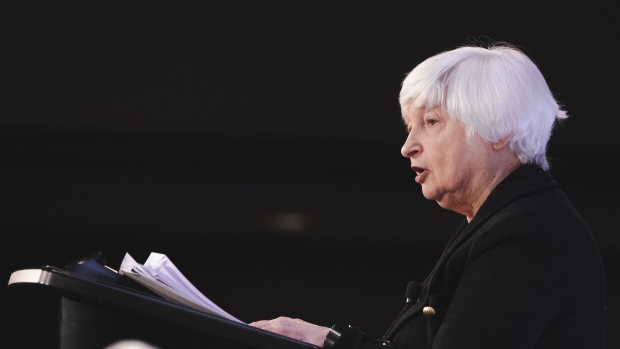Jan 26, 2024
Yellen Says Jury Out on Return to Low-Rate Era, Signaling Shift
, Bloomberg News

(Bloomberg) -- Treasury Secretary Janet Yellen said it’s not yet clear where interest rates will settle after the volatility of the pandemic and the post-Covid recovery, suggesting a shift in her views on the issue over the past year.
“There are people who feel quite strongly that nothing fundamentally has changed, and they will eventually settle back to levels” that prevailed before the pandemic, Yellen said Friday, referring to interest rates. “But the strength of the economy also suggests that perhaps productivity growth and potential output growth have increased and the level would be higher,” she added.
As for where she stands, “I don’t want to express a view,” Yellen said in Milwaukee, Wisconsin, on Friday. “I think the jury’s still out.”
A year ago, Yellen said persistently weak inflation was likely to return as a long-term challenge for the economy. She also said last January that “I do not think we’re in any way back to the ’80s and ’70s” — a period when benchmark interest rates were notably higher than during the first two decades of the current century.
The Treasury chief is in Wisconsin as part of a Midwest trip where she’s promoting the Biden administration’s economic policies.
Key Question
She said that higher longer-run rates would come hand-in-hand with a higher long-run rate of growth for the US economy. “And a higher growth rate is fiscal positive,” she said.
The question of interest-rate levels is an important one, Yellen said, since it has enormous implications for how much it costs the federal government to service its massive debt load.
Rates were historically low for most of the decade preceding the impact of Covid-19. The post-pandemic burst of inflation forced the Federal Reserve to ramp up rates, driving up the cost to service that debt and contributing significantly to the $2 trillion deficit recorded in the 2023 fiscal year.
Yellen has long said that the US debt burden remains manageable. Instead of tracking overall borrowing as a proportion of the economy’s size — which has reached a level that alarms many economists and commentators — she watches the cost to service the debt, adjusted for inflation, as a percentage of GDP. So far, the increase in borrowing obligations and higher interest rates haven’t moved that measure substantially.
But Yellen also has conceded that if interest rates remain elevated, that would spell trouble for the country’s ability to carry the debt load and finance the rest of the US budget.
(Updates with further comments and context starting in second paragraph.)
©2024 Bloomberg L.P.






